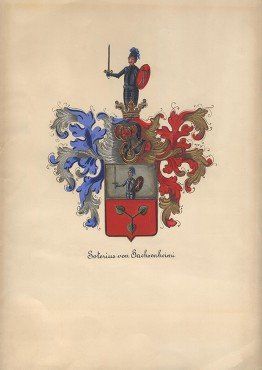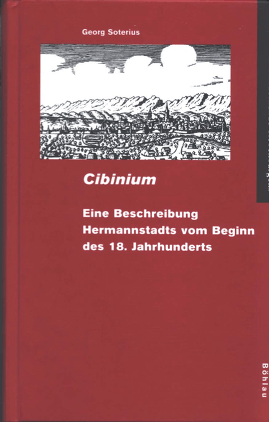Georg Soterius (The Elder)
1673-1728
Became a Lutheran pastor and wrote a book called 'Cibinium' about the history of Transylvania.
Georg, the Elder was born before 1673 in Bodendorf (Buneşti) near Schãssburg in Romania. He was the son of Pastor Petrus Soterius. He attended the gymnasium (grammar school) in Hermannstadt (Sibiu or Nagyszeben) and thereafter he studied theology and history in Wittenberg from 1693 - 1696. Soterius was wrongfully linked to a duel, in which one of his friends was involved. This prevented him from returning home because he was worried that as a consequence, he might not be able to find employment there. Instead he went via Hamburg to Riga in Latvia where he landed on 12th May 1696. One of his Wittenberg pastors recommended him to the protestant pastor of Ninhausen in Livonia, there he taught two boys.
He then enlisted at the University of Dorpat in Latvia and stayed in Marienburg (Alūksne in Latvia) in the house of pastor Johann Ernst Glück, who had fostered an orphan girl from the age of three (now aged twelve) from Lithuania. Her name was Marta Helena Skowrońska, the daughter of Samuel Skowroński, (later spelt Samuil Skavronsky) a Lithuanian peasant, who, with Marta's mother had died in the plague.
When it was time to leave, the poor young girl presented Georg, her beloved teacher, with a small knife as a parting gift, the ivory handle scales are still kept within the Soterius v. Sachsenheim family.
Afer many twists and turns, in 1705 Martha converted to Orthodoxy and took the new name of Catherine Alexeyevna, she then, despite her uncertain start in life, became the wife of Peter the Great Tsar of Russia and became Tsarina Catherine I.
Georg Soterius had returned to Hermannstadt. In 1701 he married Agnetha Lupinus, a pastor's daughter. They had two children, Georg (born 1704) and Andreas (born 1707). He taught at the gymnasium in Hermannstadt until 1708. Initially, he had intended to go to Upsala in Sweden to study the Codex Argenteus (bible translation).
However, his family persuaded him to stay at home. Here he extensively used the library in the Frankensteins’ house on the Great Ring to compose a detailed work on the geography and history of Transylvania, a hugely ambitious undertaking at the time of the early 18th century. He had a great knowledge of ancient and modern languages. His enthusiasm for the history of his native country was such, that he would spare no effort to successfully uncover buried sources of information wherever he could find them.
He was aware of the historian Conrad Schurzfleisch, Schurzfleisch had worked on the history of Hungary and Transylvania, this encouraged Georg with his work.
As preparation for this proposed major work, he put into writing many of his preliminary studies, some of which are in the possession of the family. A large part of this work in Latin and German is kept in the Bruckenthal Museum Library. The family also have several religious works in their possession, also a script on the philosophers, and a fragment of a Transylvanian legal history document, as well as a treatise on politicians. This last work is written in German and Latin, whilst the rest are written in Latin with some Greek passages.
His book was finally published and is called ‘Cibinium’ from the Latin name for the town taken from the name of the river 'Cibin'. It has been translated from Latin into German by Dr Lore Poelchau in 2006 for the Transylvanian Library in Schloss Hornek, Gundelsheim, Germany. The book in German can be bought on the internet. There are also fascinating drawings included in the book, such as maps, sketches of buildings and the town crest which were drawn by Georg . A lot of the original Latin text of Georg's work is held in the library of the Brukenthal museum. Other books and articles that Georg wrote are listed in the pages of 'Cibinium'.\
From Hermannstadt in 1708 he was called to be Lutheran pastor in Deutsch-Kreuz. He actually had applied for this rather quiet position in order to continue and eventually finish his historical works. As reported in an issue of the "Blätter für Geist, Gemüt und Vaterlandkunde" He was a Lutheran pastor, one of the followers of the teachings of Martin Luther (1483- 1546) who was the German leader of the Protestant reformation. It is worth noting here that there were several Lutheran pastors in the family.
It was in this remote tranquil parish where he received a letter from the Czar's palace. His former pupil, the Empress Catharine I remembered him as her teacher. As a great favour, she offered him a position at the Czar's court. Soterius however, did not desire worldly goods and he refused to leave his parish. He died of a stroke in Stolzenburg (Szelindek or Slimnic) on 10th February 1728. He was survived by his wife Agnetha who outlived him by 25 years. She died on 11th November 1756.
Their son Georg is written about separately. Their son Andreas married Anna Marie Wankhel von Seeberg (1721-89) they had two sons Samuel and Andreas, they both married and their family lines continue but that's another story. Andreas died on 9th June 1775 in Hermannstadt (Sibiu or Nagyszeben).
This article is taken from the family history book compiled by Fritz Soterius von Sachsenheim.
This document has been translated by www.janserKraft.com

